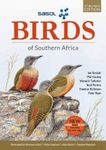![Étude Ornithologique Préliminaire de la Zone Cotière du Nord-Ouest de la Guinée [Preliminary Ornithological Study of the Coastal Zone of North-West Guinea] Étude Ornithologique Préliminaire de la Zone Cotière du Nord-Ouest de la Guinée [Preliminary Ornithological Study of the Coastal Zone of North-West Guinea]]()
Click to have a closer look
About this book
Customer reviews
Related titles
About this book
Language: French with trilingual summary in English, French, and Dutch
This report gives the results of a short trip to Guinea (West Africa), which the authors made from 16 January to 13 February 1988 on behalf of the International Council for Bird Preservation (ICBP) and the Foundation Working Group International Wader- and Waterfowl Research (WIWO). The mission took place on request of the Guinean authorities and was financially backed by the Vereniging tot Behoud van Natuurmonumenten (The Netherlands).
The aim of the mission was twofold. Firstly, we wanted to get an idea of the ornithological wealth of coastal Guinea, in particular of the Isles of Alcatraz and Tristao. The latter were proposed by the Guinean goverment as a possible future bird reserve, though the importance for birds of the islands was not definitely established. Secondly, consultation with the authorities was planned to attain a fruitful cooperation between Guinea and the ICBP/WIWO in the near future.
In comparison with other West African countries, wetlands in Guinea cover a considerable area. Especially important are mangrove swamps (± 2500 km2), mudflats (± 500 km2) and rice fields (± 780 km2). The mangroves are of importance as a foraging and resting zone for 100 000‘s of birds. This concerns both Palearctic migrants and African species, the latter also partly as breeding birds. From the mangrove belt there is a continuous stream of nutrients to the adjoining mudflats and shallow coastal waters, which is of
importance for food abundance for waders and for sustaining fish and shrimp nurseries.
The mudflats of Guinea may hold c. 350 000 waders of predominantly Palearctic breeding origin during the northern winter (October – March) . Besides they support 1000's of other waterbirds, especially herons and egrets. The rice fields may be, as long as they are wet, a foraging area for 10 000's of wading birds, probably without causing important damage to crops. Both on the island of Alcatraz and Pani Bankhi, an islet off the Tristao archipelago, important breeding colonies have been found of the Brown Booby Sula leucogaster (± 3000 pairs) and Caspian Tern Sterna caspia (± 350 pairs), African Spoonbill Platalea alba (± 55 pairs) and Sacred Ibis Threskiornis aethiopica (± 20 pairs) respectively.
The complex of wetlands along the coast of Guinea is of international ornithological importance. Threats concern especially the mangrove swamps, which can be considered as a "key-habitat" in the coastal wetlands, and disturbances in colonies of waterbirds. Thus the creation of 2-3 mangrove reserves is recommended, which include all types of coastal wetland and the most important bird areas along Guinea's coast. Continuation of the research, starting with an inventory of the whole coastal area, is therefore needed in order to map these most important bird areas.
Finally it is stated that all larger colonies of waterbirds, especially those on islands/islets off the coast, merit complete protection. That also concerns the areas which were visited in Jan/Febr. 1988, Alcatraz and Pani Bankhi. In the report recommendations are made for such protection.
Customer Reviews






![Étude Ornithologique Préliminaire de la Zone Cotière du Nord-Ouest de la Guinée [Preliminary Ornithological Study of the Coastal Zone of North-West Guinea] Étude Ornithologique Préliminaire de la Zone Cotière du Nord-Ouest de la Guinée [Preliminary Ornithological Study of the Coastal Zone of North-West Guinea]](http://mediacdn.nhbs.com/jackets/jackets_resizer_xlarge/50/50227.jpg?height=620)
![Étude Ornithologique Préliminaire de la Zone Cotière du Nord-Ouest de la Guinée [Preliminary Ornithological Study of the Coastal Zone of North-West Guinea]](http://mediacdn.nhbs.com/jackets/jackets_resizer/50/50227.jpg)




























![Aves Acuáticas en los Humedales de Cuba [Waterfowl of the Wetlands of Cuba]](http://mediacdn.nhbs.com/jackets/jackets_resizer_medium/16/161540.jpg?height=150&width=99)
